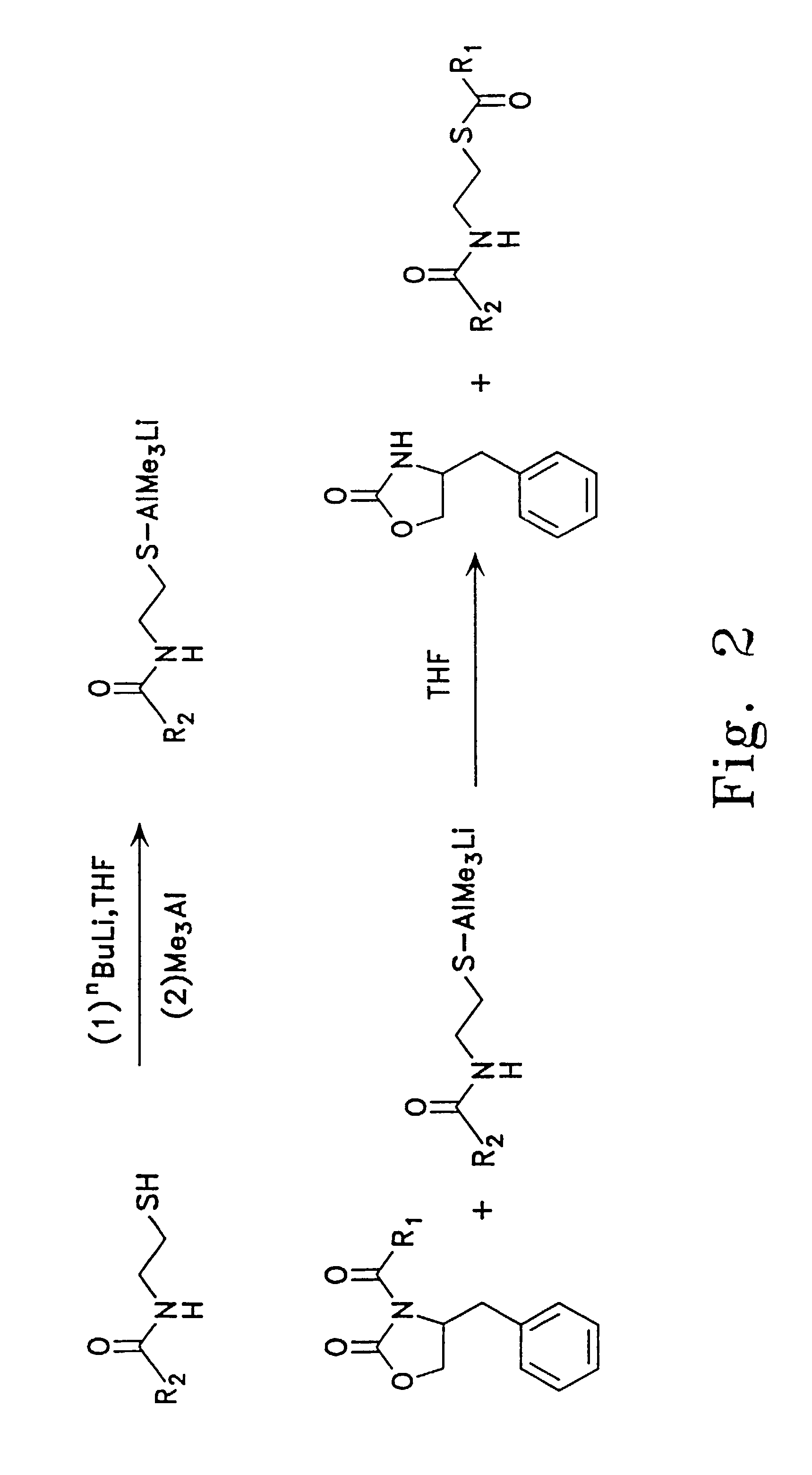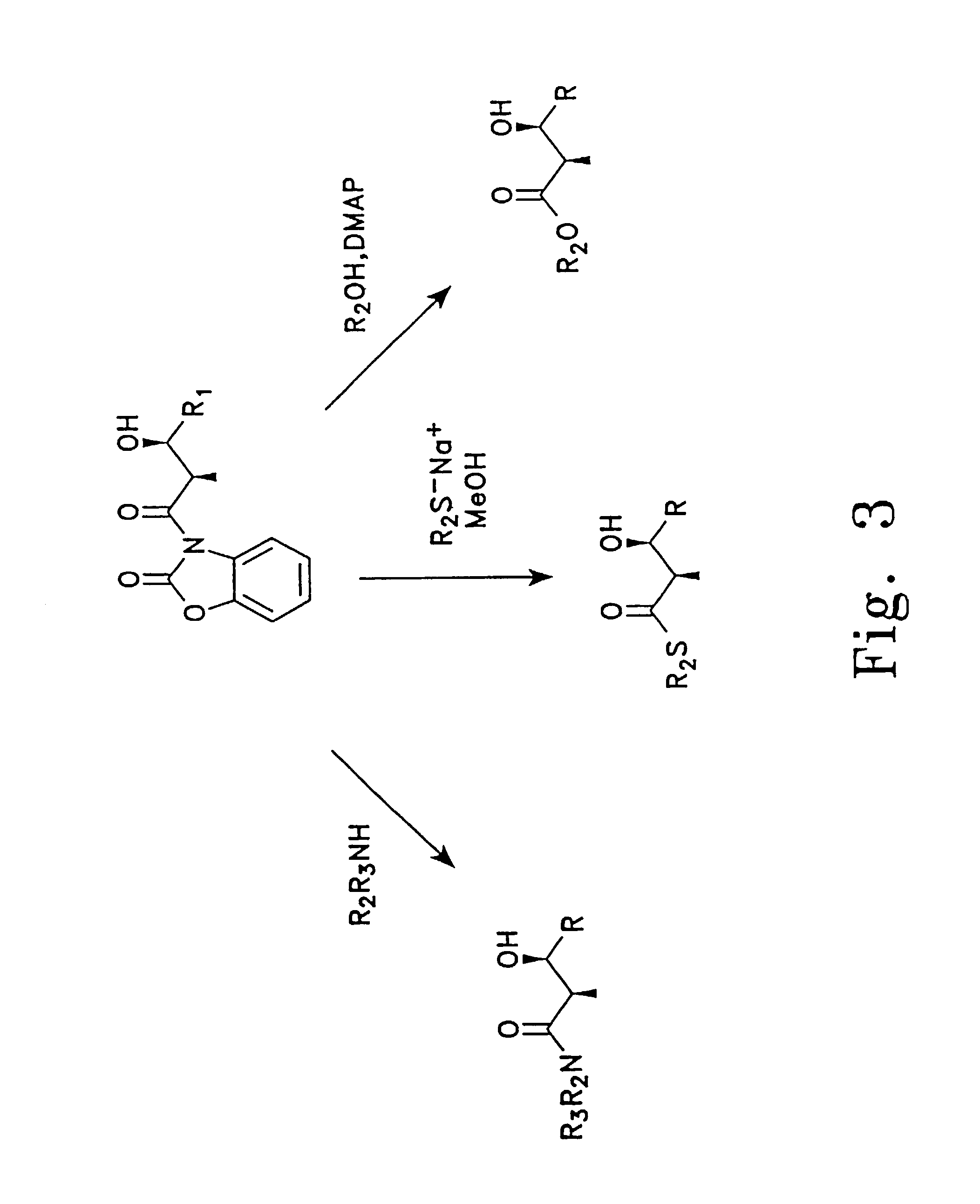Polyketides and antibiotics
a technology applied in the field of polyketides and antibiotics, can solve the problems of limiting this methodology, limiting the choice of starter units, and limiting the flexibility of resulting hybrid systems, so as to improve the efficiency of diketide synthesis
- Summary
- Abstract
- Description
- Claims
- Application Information
AI Technical Summary
Benefits of technology
Problems solved by technology
Method used
Image
Examples
preparation b
Preparation of N-Acylcysteamines
A. N-Acetylcysteamine:
[0083]N,S-diacetylcysteamine (42.64 g) is placed in a 2-L round bottom flask fitted with a magnetic stirrer, and dissolved in 1400 ml of water. The flask is purged with N2, and the mixture is chilled on an ice bath. Potassium hydroxide (49.42 g) is added, and the mixture is stirred for 2 h on ice under inert atmosphere. The pH is adjusted to 7 using 6 N HCl, and solid NaCl is added to saturation. The mixture is extracted 7 times with 500 ml portions of CH2Cl2. The organic extracts are combined, dried over MgSO4, filtered, and concentrated under reduced pressure to yield 30.2 g (96% yield) of product. This material is distilled immediately prior to use, bp 138–140° C. / 7 mmHg.
B. N-Propionylcysteamine:
[0084]A solution of N,S-dipropionylcysteamine (18.9 g) in methanol (100 mL) is placed under a nitrogen atmosphere with stirring. A solution of sodium methoxide (25 wt %) in methanol (ca. 22 mL) is added slowly until analysis by thin-la...
example 1
Preparation of (2S,3R)-2-methyl-3-hydroxyhexanoate N-acetylcysteamine thioester
A. (4S)-N-[(2S,3R)-2-methyl-3-hydroxyhexanoyl]-4-benzyl-2-oxazolidinone
[0086]A dry, 2 L three-necked round bottomed flask equipped with a 500 ml addition funnel, a low-temperature thermometer, and a stir bar was charged with 19.84 g of N-propionyl-oxazolidinone, capped with septa and flushed with nitrogen. Anhydrous dichloromethane (100 ml) was added by cannula and the resulting solution was cooled to −65° C. in a bath of dry ice / isopropanol. The addition funnel was charged by cannula with 100 ml of dibutylboron triflate (1.0 M in dichloromethane), which was added in a slow stream to the reaction. Triethylamine (15.6 ml) was added dropwise by syringe, keeping the reaction temperature below −10° C. The reaction was then transferred to an ice bath and allowed to stir at 0° C. for 30 minutes. After that period, the reaction was placed back into the dry ice / isopropanol bath and allowed to cool to −65° C. Buty...
example 2
Comparative Feeding of Diketide N-Acylcysteamine Thioesters
[0090]The N-acylcysteamine thioesters of (±)-(2S*,3R*)-2-methyl-3-hydroxy-hexanoate were fed to growing cultures of Streptomyces coelicolor CH999 / pJRJ2, and the production of 15-methyl-6-deoxyerythronolide B was monitored. Duplicate cultures were grown in 50 ml of medium (sucrose (103 g / l), K2SO4 (0.25 g / l), MgCl2.6H2O (10.12 g / l), casaminoacids (0.1 g / l), yeast extract (5 g / l), TES buffer (5.73 g / l), sodium propionate (10 mM), and trace elements) supplemented with 50 ug / ml of thiostrepton. After 2 days post-inoculation, the cultures were fed with a solution of diketide thioester in 9:1 water / DMSO to give a final concentration of 0.5 mM diketide thioester. Aliquots of the cultures were removed periodically and assayed for polyketide production by HPLC, with quantitation performed by evaporative light scattering. Production of 15-methyl-6-dEB 6 days after feeding was as follows:
[0091]
Yield ofAcyl group15-methyl-6-dEBAcetyl26 ...
PUM
| Property | Measurement | Unit |
|---|---|---|
| temperatures | aaaaa | aaaaa |
| temperature | aaaaa | aaaaa |
| temperature | aaaaa | aaaaa |
Abstract
Description
Claims
Application Information
 Login to View More
Login to View More - R&D
- Intellectual Property
- Life Sciences
- Materials
- Tech Scout
- Unparalleled Data Quality
- Higher Quality Content
- 60% Fewer Hallucinations
Browse by: Latest US Patents, China's latest patents, Technical Efficacy Thesaurus, Application Domain, Technology Topic, Popular Technical Reports.
© 2025 PatSnap. All rights reserved.Legal|Privacy policy|Modern Slavery Act Transparency Statement|Sitemap|About US| Contact US: help@patsnap.com



